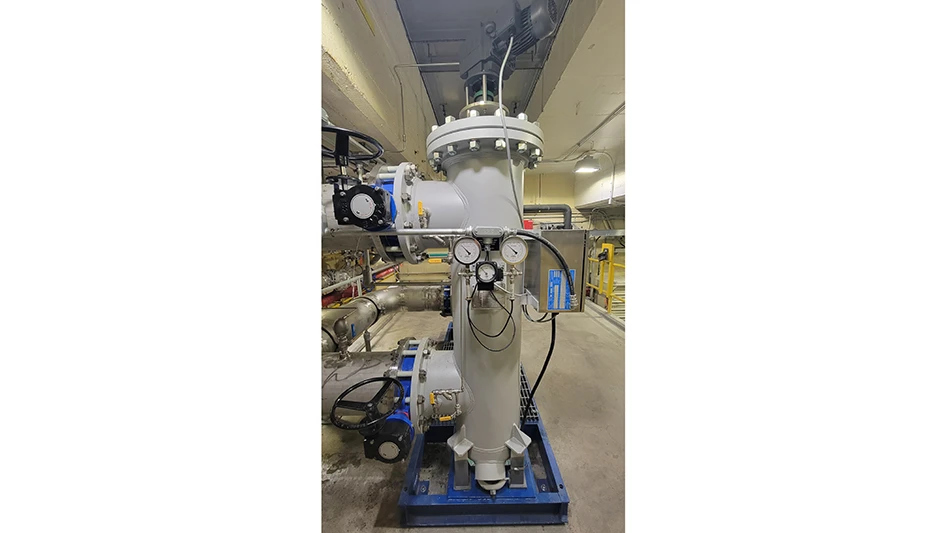
Photo courtesy Acme Engineering
The food processing industry depends on industrial strainers to separate unwanted suspended solids from liquids and slurries. The utilization of a blend of industrial wastewater technologies now allows for the removal of solids without the need for extensive manual labor, worker exposure to messy or potentially hazardous substances, or constant maintenance, said Acme Engineering Prod., Inc., a North American manufacturer of industrial self-cleaning strainers.
Acme’s design involves a one-two punch combination of a macerator, which breaks down large solids into smaller fragments, and an automated scraper strainer flexible enough to filter out larger debris along with tiny particles. This solution can even accommodate high solids loading without clogging, the company said.
Duplex strainers are often used in continuous flow processes that cannot be shut down for cleaning purposes. Duplex basket strainers employ two distinct chambers that function independently. When one chamber needs cleaning, the flow is seamlessly diverted to the alternate chamber, enabling the removal and cleaning of the first basket.
Cleaning involves equalizing pressure between the baskets, diverting flow to the off-line chamber, opening the cover, manually removing the clogged basket and cleaning it before refitting the basket, ensuring the seal and tightening the fasteners.
If an operator fails to adequately clean the basket strainers for any reason, both strainers can become clogged at the same time. This compromises the filtration process, resulting in quality issues or unexpected downtime until the problem is resolved. For many food processors, this can occur simply due to having insufficient personnel to keep basket strainers clean along with their other duties.
“As an alternative, a combination of established complimentary technologies such as a macerator and an automated scraper strainer can essentially ‘knock out’ even the toughest problems related to large solids and high solids loading in an automated way,” said Robert Presser, vice president of Acme, an ISO 9001:2015 certified manufacturer of environmental controls and systems with integrated mechanical, electrical and electronic capabilities.
In this configuration, a macerator would be installed upstream to reduce large solids down to a manageable size. The capabilities of the automated strainer are crucial to the process as well, according to Presser.
“Although the macerator cuts up the biggest solids, the strainer must still be able to separate both relatively large pieces and tiny particles while handling high solids loading without becoming obstructed,” said Presser.
In the case of Acme, the OEM’s automated scraper strainer is designed to continually remove both large and small suspended solids from liquids and slurries. Cleaning is accomplished by a spring-loaded blade and brush system, managed by a fully automatic control system.
Four scraper brushes rotate at 8 RPM, resulting in a cleaning rate of 32 strokes per minute. The scraper brushes get into wedge-wire slots and dislodge resistant particulates and solids. This approach enables the scraper strainers to resist clogging and fouling when faced with large solids and high solids concentration, said Acme.
Blowdown typically occurs only at the end of the intermittent scraping cycle when a valve is opened for a few seconds to remove solids from the collector area. Liquid loss is well below 1% of total flow, said the company.
If additional pressure is required to clean the screen, Acme Engineering can add a trash pump to the blowdown line to assist in removing the solids from the strainer sump.
“Since the solids are small, a little trash pump can pressurize the blowdown line to evacuate solids from the strainer. The combination provides quick ROI because operators no longer have to monitor and clean out heavily loaded basket strainers, resulting in substantially less labor and downtime,” said Presser.
Alternatively, the sump can be replaced by a cylinder bracketed by two gate valves that open and close as needed to remove the solids waste.
“When you are ready to empty the cylinder, you close the top gate valve momentarily and open the bottom one by depressing a button to dump the accumulated solids into a receptacle like a dump truck or a conveyor bucket so there is no manual handling required,” said Presser.
According to Presser, adapting strainers for the specialized filtration of uncommon liquids and slurries requires not only expertise but also collaboration with the processor as well as some design iterations.
“For unusual applications, it may take a few attempts to get it right. You may have to adjust the timing and frequency of cleaning as well as adjust the screen slot size. There are quite a few variables involved,” said Presser.
Latest from Quality Assurance & Food Safety
- IDFA Presents Leadership Award to Six Federal Officials at Annual Celebration of Dairy Reception
- Seeding The Future Global Food System Challenge is Changing Lives: Winners Reflections
- Raw Farm Products Recalled Following Bird Flu Virus Detections
- FDA Issues 2024 Voluntary National Retail Food Regulatory Program Standards
- GSA Launches Assurances Platform, Prism and Webinar Series in Partnership with Wholechain
- Multistate E. coli Outbreak Linked to Iceberg and Romaine Lettuce Blend
- FDA, USDA Seek Information About Food Date Labeling
- William Marler, Food Safety Advocate and Lawyer, Condemns Lack of Safety of U.S. Food Supply





